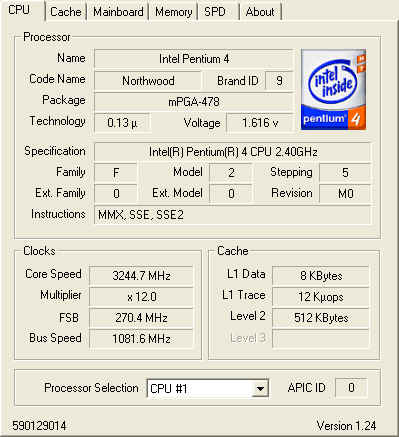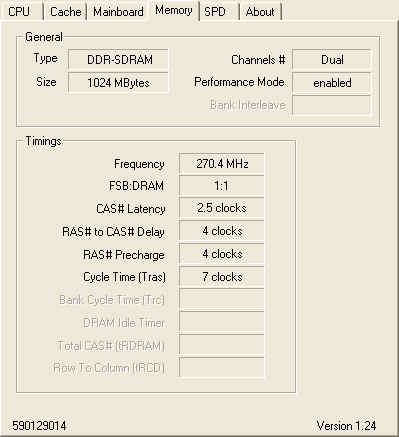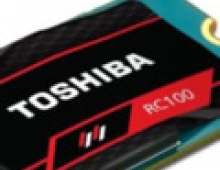OCZ EL DDR PC-3200 Dual Channel Platinum Revision 2
3. The Tests
Review Pages
The tests
The following BIOS settings were used during our tests.
DRAM Frequency: 400Mhz (1:1 divider)
AGP/PCI Frequency: 66.66/33.33
CPU CVore Voltage 1.5250-1.6000
DDR Reference Voltage: 2.85V
AGP VDDQ Voltage: 1.60V
Performance Mode: Turbo
DRAM Idle Timer: Infinite
DRAM Refresh Rate 15.6usec
Spread Spectrum: Disabled
ICH Delayed Transaction: Disabled

As you can see from the screenshot above, CPUZ reports the SPD values of the OCZ EL DDR PC-3200 Dual Channel Platinum Revision 2 memory, which for 200MHz is a very impressive 2-2-2-5.
After the initial test at the default frequency of 200MHz, we started increasing the frequency, using each time the tightest possible timings so that the test PC would POST, and then running the tests mentioned previously.
While tempted to use frequency dividers other than 1:1, like 5:4, we refrained from doing so. Our goal was not to see how far our CPU would go. The purpose is to see how the OCZ EL DDR PC-3200 Dual Channel Platinum Revision 2 would perform and how high its overclocking potential is.
In that department, we had very encouraging info from OCZ Technologies themselves, and word going around the various harware forums on the Internet. This model from OZC, while rated PC-3200 can be overclocked to a great extent.
Summarizing, we tested the following FSB/Timings/DDR Voltage:
| FSB | Divider | Memory Timings |
DDR Voltage |
CPU Speed | Comment |
| 200 | 1:1 |
2-2-2-5 | 2.85Volts |
2.40 | |
| 215 | 2-2-2-5 | 2.58 | Highest FSB with these timings | ||
| 220 | 2-3-3-5 | 2.64 | |||
| 235 | 2-3-3-5 | 2.82 | Highest FSB with these timings | ||
| 250 | 2.5-3-3-5 | 3.00 | |||
| 250 | 2.5-3-3-7 | 3.00 | |||
| 265 | 2.5-3-3-7 | 3.18 | Highest FSB with these timings | ||
| 270 | 2.5-4-4-7 | 3.24 | Highest FSB with these timings | ||
| 275 | 3-4-4-8 | 3.30 | Highest usable FSB | ||
| 280 | 3-4-4-8 | 3.36 | PC would POST ok, Memtest would complete ok, but Windows crash at startup | ||
| 285 | 3-4-4-8 | 3.42 | PC would POST ok, Memtest would complete ok, but Windows crash at startup |
As you can see, with FSB 285 MHz (1:1) the CPU reaches the incredible 3.42 GHz. Bearing in mind this was a 2.4GHz processor, it is a 1 Ghz increase! Of course, the system was not usable because it would not boot Windows, however by using other methods of cooling, it could produce a stable system.
Nevertheless, the system at 275 MHz was very stable during our tests. Bear in mind that we have probably reached the CPU's limits as well, using air cooling.


Review Pages





















